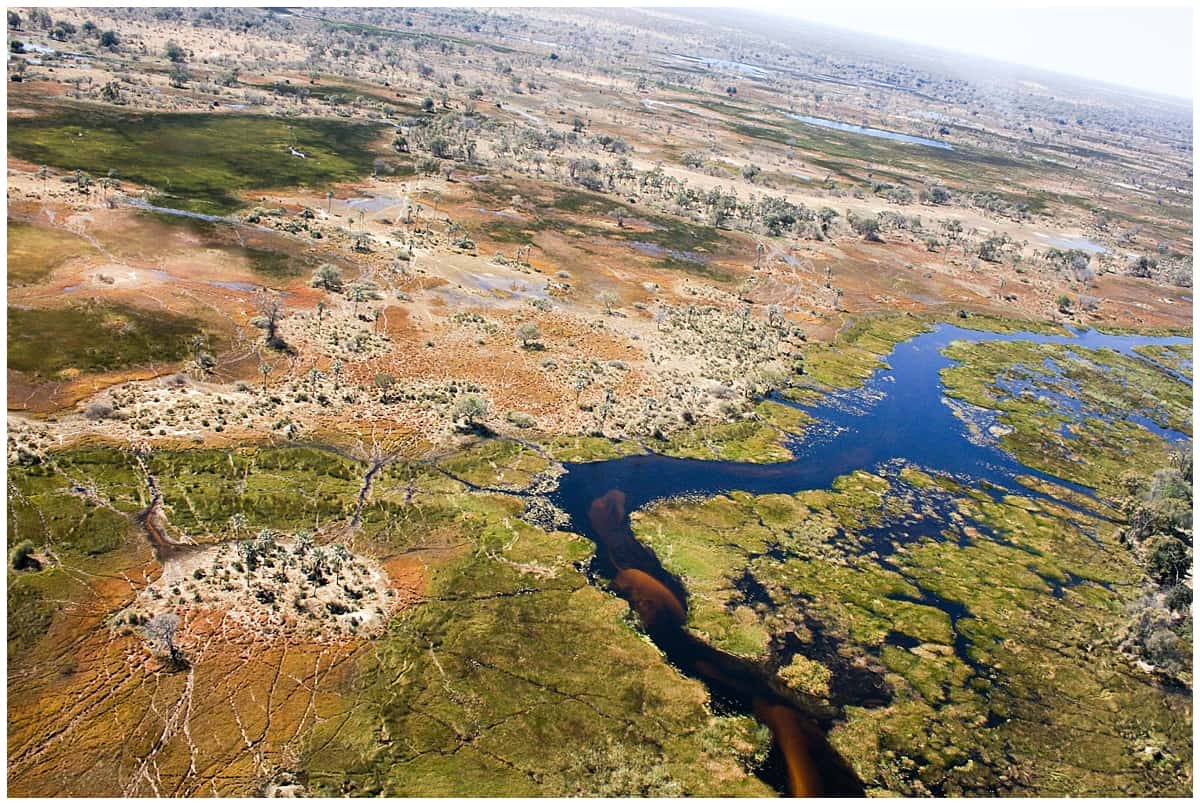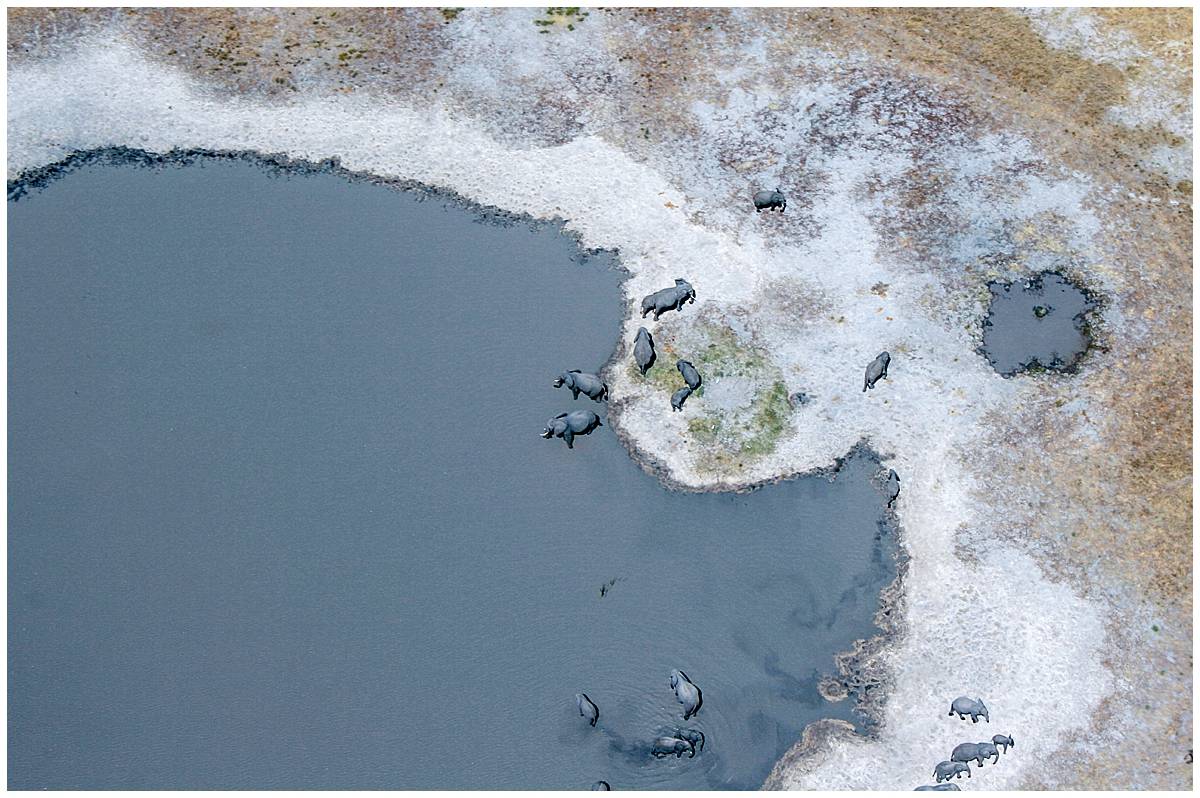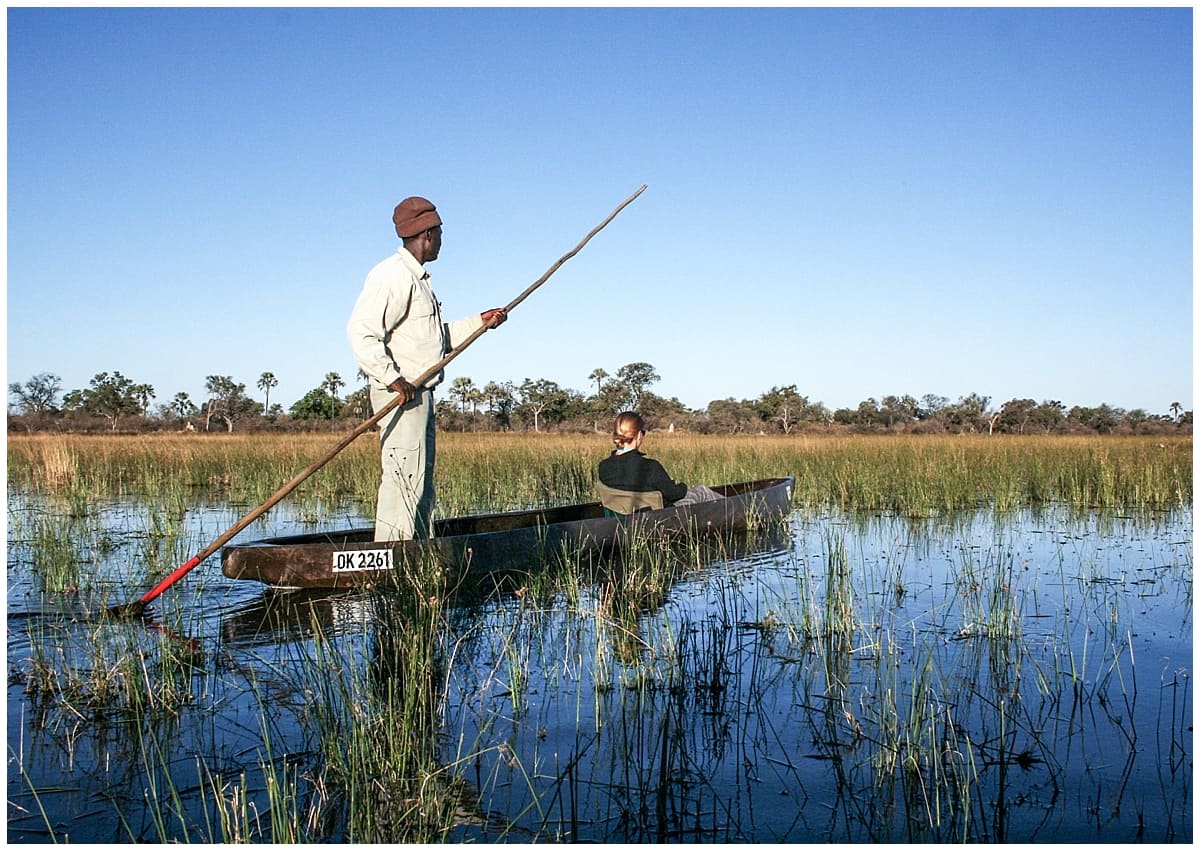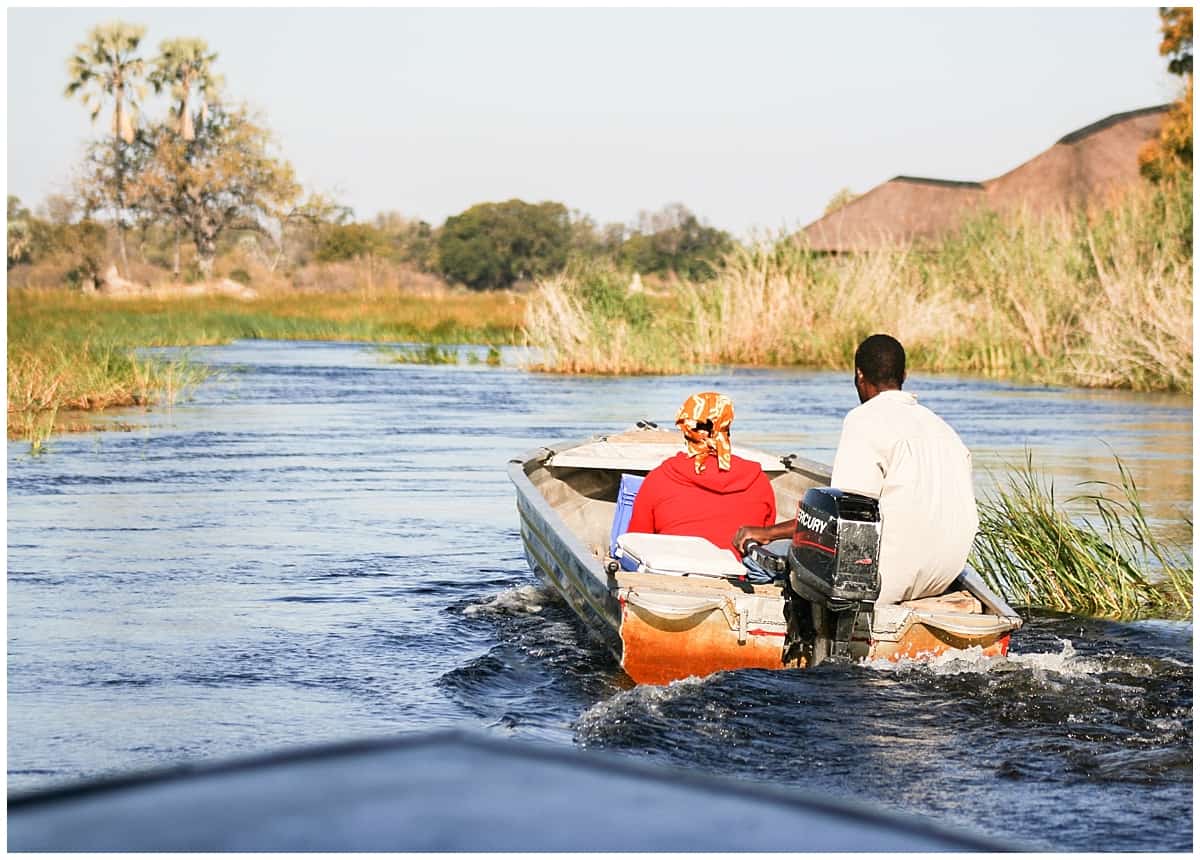The colours in this part of Botswana shimmer in deep blues and greens more than rust red and dust. And the safaris take place on mokoros on the water, instead of motor vehicles on the sand.
Here’s what it’s like to go on an Okavango Delta safari in Botswana.

This article forms part of a series on the best places to visit in Africa and the best wildlife experiences in the world.
An Okavango Delta Safari Botswana
Despite the stillness of the water, there’s no sound of silence. Insects skim across the reeds with a soft buzz and woodpeckers tap against acacia trees. Birds chatters in all directions – yet the loudest by far are the doves.
Chu charra, chu charra.
“Work harder, work harder,” says Rodger, slipping a pole into the delta and easing us forward.
“Drink lager, drink lager,” says another guide, Amos, illustrating a different point of view.
From where I’m sitting, level with the water in a slender mokoro, I hear something else. Botswana, Botswana, Botswana.
The Okavango Delta: The World’s Largest Delta
Eight hundred miles from the Atlantic and a thousand from the Indian Ocean, the Okavango Delta looks like a miniature version of the earth from the air, an expanded jigsaw of land swirls amid deep and spreading blue. Its water seeps up through the soil, having landed as monsoon rain a thousand miles north in Angola. It’s long been protected, both by government intervention and because its soggy, swampy nature makes building roads here impossible.
To get this deep into the delta, we’ve flown from Maun in a four-seater Cessna, a tiny contraption that trembled during the descent as though in awe of the expanse below. An elephant greeted us on the runway and warthogs scuttled past us in the camp.
Conservation in Botswana on the Okavango Delta
Botswana takes its wildlife pretty seriously. Even on foot, guides can’t carry firearms for self-defence, only a gunpowder-laced contraption that resembles a syringe. When an elephant veers too close to the camp, a single empty gunshot rips through the vast sky.
Should an elephant charge, or a hippo rear up from the water, our survival depends on our behaviour, we are told. Stand still, stay quiet – and if told to run, try not to fall into an aardvark hole.
Not everyone is reassured.
“Why not take a gun with you?” asks one member of our camp. “If you killed something by accident, what’s the worst that could happen?”
“A lifetime in prison,” comes the reply.
There’s a rare moment of silence before we climb aboard.
The Peace of the Kigelia Trees on the Okavango Delta
Despite the danger, it’s hard to imagine a more peaceful mode of transport. A cross between a punt and a canoe, mokoros used to be the only way to travel around here. Previous generations hand-carved them from ebony and kigelia trees but had to wait for more than 100 years for the trunk to reach the right size. Since a wooden mokoro only has a five year lifespan, the arrival of a fibreglass version was greeted with about the same enthusiasm as the discovery of sliced bread.
The Biggest Danger in the Okavango Delta
Today, boats use small motors to churn along the main waterway to Maun, carrying people, food and beer. The mokoros, however, fashion their own way through the reed fields, the long grass spreading apart before them in a deferential rustle.
This off-piste navigation isn’t just for entertainment, though.
Related: Consider combining a trip to Botswana with a visit to neighbouring Namibia and visiting Dune 45 and Sossusvlei in the Oldest Desert in the world.
“The only animal I fear,” says Rodger when I ask him, “is the hippopotamus. That is why we stay away from the main channel.”
“But,” I state the obvious. “We do need to cross it… eventually.”
Rodger sinks the pole into the delta again and water sloshes gently against the thin-walled mokoro.
“I look for bubbles,” he says slowly. He grins. “And I drive fast!”
Chu-charra, chu-charra.
The doves reach a crescendo as we glide past giraffe, baboons and impala, while Rodger keeps watch. My mind drifts to his interpretation of what the doves are saying.
Like the rhythm of the mokoro itself, his version soothes me.
Further Reading on an Okavango Delta Safari in Botswana
Interested in safaris? Think about how we can save endangered animals.
Many international flights to Botswana connect in South Africa, in particular Johannesburg, so don’t overlook this up and coming city with a huge legacy from Nelson Mandela.
How to Arrange a Mokoro Tour
The Okavango Delta in Botswana (the largest delta in the world) is home to elephants, impala, giraffe, hippos and warthogs aplenty. Its watery nature means that there are virtually no roads – so the only ways of getting around are by boat or by plane.
Both versions will give you a truly amazing experience: either up close with the reeds and the animals in a traditional mokoro*, or gazing down at the swirls of the delta from the sky. Let me warn you now: both options are expensive.
*a mokoro – is a cross between a canoe and a gondola and used to be the traditional mode of transport on the Okavango Delta. It was previously carved from kigelia trees but since they take over 100 years to grow to the correct size, people now happily use fibreglass.
Most safari lodges in this part of Botswana operate on a fly-in, fly-out basis.Flights leave from Maun, a small but growing town on the edge of the Okavango. It’s not the most exciting of places but it’s a nice base if you want a brief taste of local life – and it’s a good start for organising independent trips into the Okavango itself.
Book a stay at a fly-in, fly-out safari lodge yourself or through a tour operator
Botswana has a deliberate “low volume, high cost” tourist policy and most visitors will have booked their trips months in advance through a travel agent. It’s virtually impossible to separate booking a safari from booking accommodation, since you’ll be staying in a remote lodge. Prices include food, usually drink, safaris and occasionally flights.
Gunn’s Camp
When I went (with absolutely no forward planning whatsoever), we managed to find a couple of nights (flights included) in Gunn’s Camp. With an elephant waiting for us on the runway, there was no mistaking that this was in the thick of the Okavango.
Thatched huts seemed to grow out of the reeds, warthogs scuttled past and we needed trained guides to escort us back to our (extravagant) tents after dark. The tents may have had walls of canvas, but inside we found a desk, two beds, several chairs, a chest of drawers and more space than we had stuff to scatter around.
Gunn’s Camp provides both walking safaris on the small islands of the Delta and mokoro safaris through the reeds. Food is plentiful, varied and tasty – and you eat with the other guests (which was hilarious in our case but it’s always going to be a lottery as you don’t know who else will be there. )
What to Wear
You’ll need to blend in with nature without looking like a predator (leopard skin is definitely out.) Stick to greens, browns and white if you have to. If you turn up with a red or pink jacket, you won’t be allowed to go. Although it’s blisteringly hot in the afternoon (take plenty of sunscreen), dawn and dusk are cold. Take hats, scarves and a proper warm jacket.
Health Checklist
Make sure you’ve had all your vaccinations, that you have sought advice about anti-malarials and that you take plenty of long-sleeved cotton shirts and trousers and bucket-loads of insect repellent. You can do most things at the last minute, but not health prevention. Ask for advice at least two months before you plan to travel.
Flights
Most people fly in to Johannesburg and then either connect directly to Maun, or fly to Windhoek to combine Namibia with the Okavango Delta trip. The drive between Windhoek and Maun takes about 12 hours along a smooth, tarmac road. British Airways and South African Airways fly from London to Johannesburg.
More About Travel in Africa
- The best places to visit in Africa: how to build your bucket list
- Namibia and the oldest desert in the world
- The best beaches in Madagascar
- What safari guides really fear in Botswana’s Okavango Delta
- How the red tsingy in Madagascar are the perfect antidote to travel overload.
- The real pride rock
- Why Ouirgane valley in Morocco deserves your time
- The highs and lows of driving in Morocco
- What you need to know about trekking Kilimanjaro




I dream of doing a safari one day!
Botswana’s a great choice, then. You can do the “classic” road vehicle trips to see elephants, rhinos and cats and then hop in a mokoro and hope to see slightly smaller creatures ;)
going on a safari in africa is a dream.. hope i’ll do this one day..
I hope you do too – good luck!